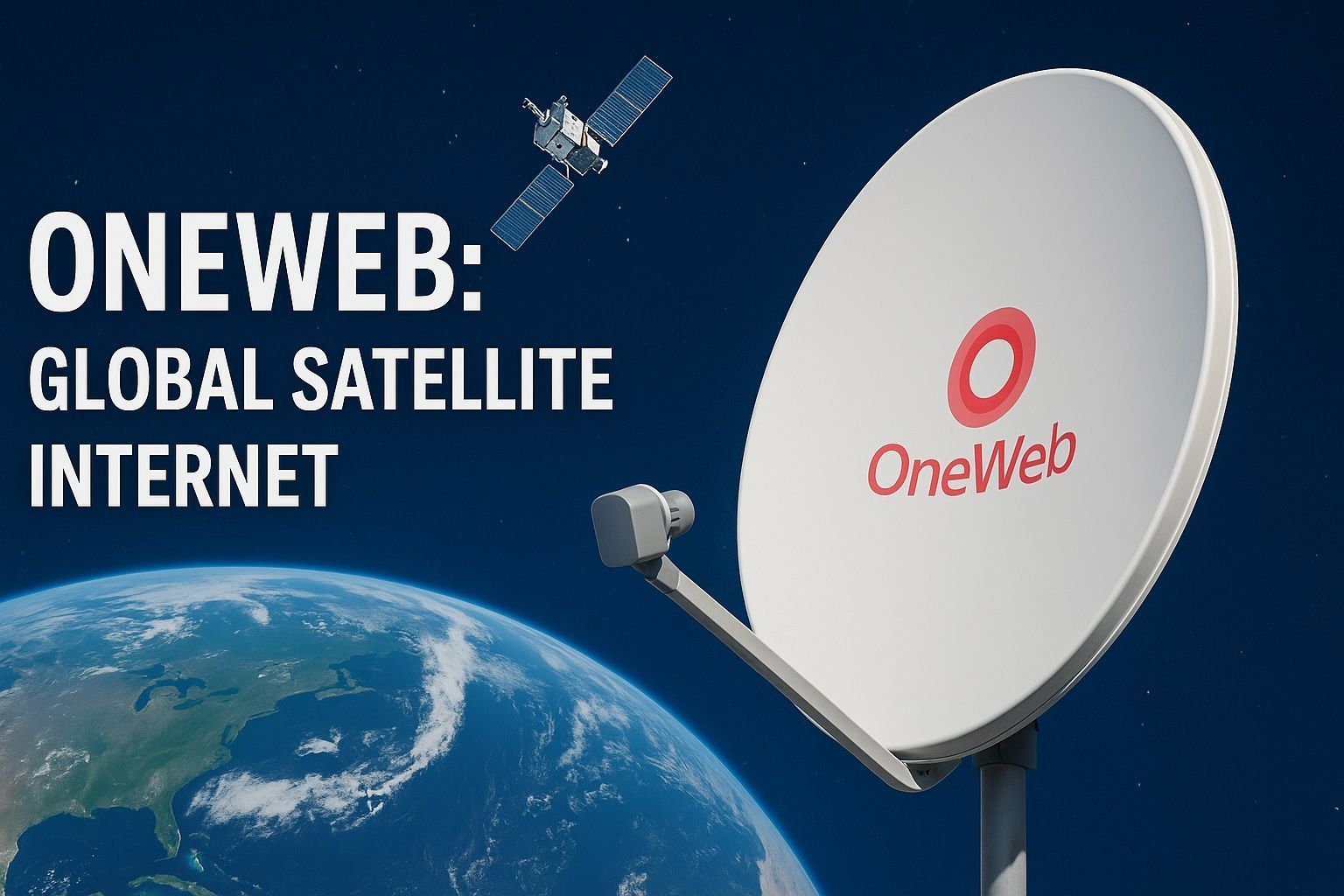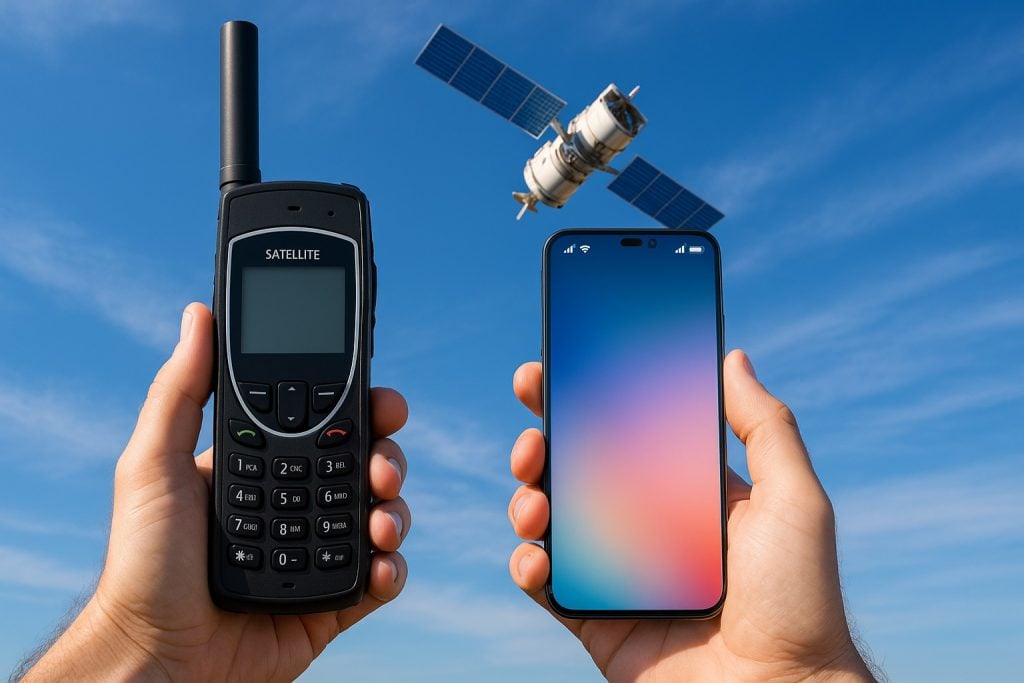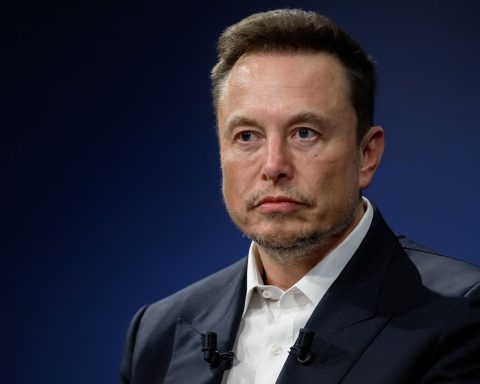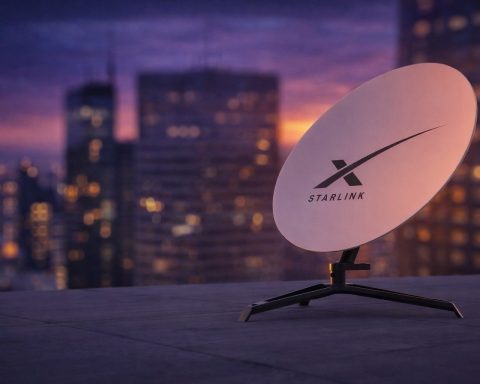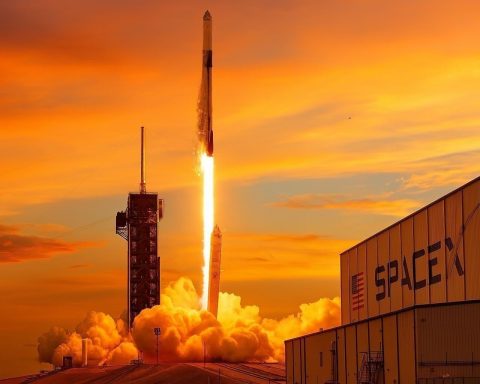- OneWeb’s first-generation constellation comprises 648 LEO satellites at about 1,200 km altitude, each ~150 kg, using Ku-band for user links and Ka-band for gateways, with 16 spot beams and no inter-satellite laser links, delivering up to 7.2 Gbps per satellite.
- By late 2021, OneWeb achieved partial service in high-latitude regions, focusing on the Arctic, Northern Europe, Greenland, and Alaska.
- On March 25, 2023, the first-generation constellation reached 614 operational satellites, exceeding the minimum ~588 satellites required for global coverage, with 648 planned total.
- In September 2023, OneWeb merged with France’s Eutelsat to form Eutelsat OneWeb, making Eutelsat the 100% owner while the UK government retains a golden share.
- OneWeb filed for Chapter 11 bankruptcy in March 2020 and exited in November 2020 after a rescue by the UK government and Bharti Global, with a post-bankruptcy restart of launches in late 2020.
- In 2024 OneWeb ordered 300 Gen 2 satellites from Airbus for replacement and upgrades, including digital regenerative payloads and beam hopping, with launches planned for 2025–2026, and it demonstrated beam hopping with the JoeySat experiment in 2023.
- OneWeb’s business model is wholesale and partner-driven, selling capacity to enterprises, governments, and telecom operators, with 2023 end-user pricing estimated at $1,000–$1,500 per month via resellers.
- Key partnerships include AT&T, BT, Bharti Airtel, Hughes Network Systems, Intelsat, Gogo, and AWS for co-located gateways and integrated services.
- Current tests show 50–70 ms latency with typical speeds of 50–150 Mbps down and 5–30 Mbps up, and coverage extends to land, sea, and air, including polar regions.
- OneWeb positions itself as a wholesale, enterprise-focused alternative to Starlink, leveraging polar coverage and a GEO-LEO hybrid approach through its Eutelsat ownership to win government, maritime, and aviation contracts.
Summary
OneWeb is building a global satellite internet constellation that aims to bridge the digital divide by delivering broadband connectivity to remote and underserved regions of the world. Founded in 2012, the company has deployed hundreds of small low-Earth-orbit (LEO) satellites at ~1,200 km altitude to blanket the Earth in coverage [1] [2]. Unlike SpaceX’s Starlink (which sells service directly to consumers), OneWeb has “quietly” pursued a different business model – focusing on enterprise, government, and telecommunications partners rather than individual users [3]. Backed by major investors and now merged with Europe’s Eutelsat, OneWeb has overcome bankruptcy and logistical hurdles to complete its first-generation constellation by 2023 [4] [5]. This report provides a comprehensive look at OneWeb’s satellite technology, coverage, service plans, target users, deployment timeline, business model, and funding. It also compares OneWeb with other satellite broadband players like Starlink, SES’s O3b system, and Amazon’s upcoming Project Kuiper, highlighting OneWeb’s unique position and challenges in the market.
Key Takeaways:
- Satellite Constellation: OneWeb’s initial network consists of 648 LEO satellites (150 kg each) in near-polar orbits ~1,200 km high, using Ku-band links for user connectivity and Ka-band for gateways [6] [7]. The first-generation satellites have no inter-satellite laser links, meaning each satellite relays user data to a ground station within view [8]. Each satellite can cover a vast area (~1.7 million km², about the size of Alaska) via 16 spot beams, with a total throughput up to ~7.2 Gbps per satellite [9] [10].
- Coverage and Services: OneWeb achieved partial service in high-latitude regions by late 2021, focusing on the Arctic, Northern Europe, Greenland, Alaska, and similar areas [11]. After completing launches in 2023, OneWeb is on track for global coverage – by mid-2023 it was serving most of Europe and North America, and full worldwide service was expected by end of 2023 once all satellites reached final orbit and ground stations came online [12] [13]. OneWeb offers high-speed broadband (up to ~150 Mbps down, ~30 Mbps up per user terminal in current tests) with latency around 50–70 ms [14] [15] – considerably lower latency than geostationary satellites, though slightly higher than Starlink’s due to OneWeb’s higher orbit. Services extend on land, at sea, and in the air, enabling connectivity for rural communities, ships, airplanes, and other remote operations [16] [17]. OneWeb’s network is designed to integrate with terrestrial telecom networks, providing “fiber-like” backhaul and internet extension to places fiber or cellular networks can’t reach.
- Target Users & Market Positioning: OneWeb deliberately targets businesses, governments (including defense agencies), telecom operators, and transportation enterprises rather than mass-market consumers [18]. It’s marketed as a wholesale/partner-driven service, where local telecoms and integrators use OneWeb’s capacity to serve end-users. For example, AT&T has a wholesale deal to use OneWeb satellites to extend broadband to remote U.S. areas beyond its fiber footprint [19] [20], and Britain’s BT is exploring OneWeb for rural coverage solutions [21]. OneWeb also partners with maritime and in-flight connectivity providers (like maritime ISPs and airlines via companies such as Intelsat and Gogo) to deliver internet on ships and aircraft. This business-to-business approach contrasts with Starlink’s direct-to-consumer model. OneWeb prioritizes reliability, managed services, and integration for enterprise clients, even if at higher price points, rather than chasing the lowest-cost consumer broadband [22] [23].
- Service Plans & Pricing: OneWeb’s service plans are typically sold through distributors and vary by application (land, mobility, maritime, etc.). Pricing is generally higher than Starlink’s consumer service due to the enterprise focus and bundled solutions. As of 2023, industry analysts estimated OneWeb’s connectivity to cost on the order of $1,000–$1,500 per month for end-users (via resellers), compared to Starlink’s ~$100/month consumer plans [24]. For example, one reseller’s North America plan offered 100 Mbps down/20 Mbps up with a 100 GB data cap at around $1,170 per month [25]. Maritime plans can run even higher (e.g. ~50 Mbps down with 350 GB data for ~$1,800/month) [26]. These premium prices reflect OneWeb’s strategy to provide guaranteed bandwidth and service-level agreements to commercial clients, as opposed to Starlink’s best-effort residential service. OneWeb user terminals – sourced from partners like Intellian, Kymeta, and others – are also enterprise-grade and can be tailored in form factor (fixed installations, vehicle mounts, flat panel antennas for aircraft, etc.) [27] [28]. This flexibility appeals to governments and businesses that need custom solutions, even though it means OneWeb isn’t competing to put a cheap dish on every suburban rooftop.
- Deployment Timeline:OneWeb’s journey has been dramatic. Below is a timeline of major milestones in its development and deployment:
- 2012–2015: Company founded in 2012 (as WorldVu) by Greg Wyler with a vision of global satellite internet [29]. By 2015, OneWeb secured an initial $500 million funding round from investors like Virgin Group, Qualcomm, Coca-Cola, Airbus and others [30], and contracted with Airbus Defence & Space to mass-produce its satellites [31]. It also booked launch contracts with Arianespace and Virgin Galactic in 2015 [32].
- 2016–2019: SoftBank invested $1 billion in 2016 to accelerate OneWeb’s constellation [33], bringing total raised to $1.7 billion by early 2017 [34]. OneWeb built a satellite factory in Florida (as a joint venture with Airbus) to produce satellites assembly-line style. The first test satellites were launched in February 2019 – OneWeb’s inaugural launch put 6 satellites into orbit [35]. Larger batches of 34 satellites each followed in February and March 2020 [36]. By March 2020, OneWeb had ~74 satellites in orbit, proving the system but far from full deployment.
- March 2020 – Bankruptcy: In late March 2020, OneWeb abruptly filed for Chapter 11 bankruptcy protection after failing to secure new funding to continue launches [37] [38]. The company cited the COVID-19 pandemic’s impact on investor markets as a factor [39]. OneWeb halted operations and laid off most staff, with about 85% of its 500 employees let go during bankruptcy [40].
- Mid/Late 2020 – Rescue & Restructuring: A rescue deal emerged by July 2020: the Government of the United Kingdom and India’s Bharti Global (Bharti Enterprises) jointly agreed to invest ~$1 billion (each putting in $500 million) to buy OneWeb out of bankruptcy [41]. This unusual partnership – a mix of state support and private telecom investment – gave the UK government a “golden share” (special veto power) and Bharti a major ownership stake. The acquisition was approved by U.S. courts and OneWeb officially exited bankruptcy in November 2020 [42], resuming operations with new leadership and ownership. By the end of 2020, OneWeb had restarted satellite deployments, launching 36 satellites in December 2020 to bring its constellation to over 110 in orbit [43] [44].
- 2021 – Rapid Relaunch and New Investors: With Bharti’s Sunil Mittal as Executive Chairman, OneWeb accelerated its launch schedule in 2021. A series of Soyuz rocket launches (managed by Arianespace) from Russian-operated spaceports steadily added satellites. By mid-2021 OneWeb had over 200 satellites in orbit and began beta services for high latitude regions. The company also raised new funds in 2021: $400 million from SoftBank and Hughes Network Systems in January [45], $550 million from Eutelsat in April (for ~24% stake) [46], and $300 million from South Korea’s Hanwha Systems in August for an ~8% stake [47]. These brought OneWeb’s total funding to about $2.7 billion, enough to finish the first-gen constellation [48]. By the end of 2021, OneWeb had ~358 satellites launched and was testing service in the Arctic region, aiming to expand coverage down to about 50° latitude.
- 2022 – Launch Disruption and Recovery: By early 2022 OneWeb had exceeded 428 satellites in orbit [49]. However, a major geopolitical event – Russia’s invasion of Ukraine in Feb 2022 – suddenly derailed OneWeb’s launch plans. The company had been relying on Russian Soyuz rockets (via Arianespace) for launches, but amidst sanctions and diplomatic fallout, scheduled Soyuz launches were suspended [50]. OneWeb faced the prospect of a completed constellation stranded short of its goal. In a surprising pivot, OneWeb struck a deal with its competitor SpaceX to purchase launches for its remaining satellites [51]. In essence, SpaceX’s Falcon 9 rockets (the same rockets launching Starlink) would now launch OneWeb satellites – a remarkable instance of collaboration in the otherwise heated satellite internet race. Launches resumed in late 2022 using Falcon 9 from Cape Canaveral and an Indian LVM3 rocket [52]. By year’s end 2022, OneWeb had over 500 satellites deployed.
- March 2023 – Constellation Completion: On March 25, 2023, OneWeb’s 18th launch (using India’s LVM3) placed the final 36 first-generation satellites into orbit [53]. This brought the constellation to 614 operational satellites, surpassing the ~588 satellites OneWeb identified as the minimum for global coverage [54]. (OneWeb planned 648 satellites total, with the remainder to serve as on-orbit spares and to increase resiliency [55].) With this milestone, OneWeb became the first of the new LEO broadband constellations to officially complete its initial deployment [56] – even as Starlink continued to launch thousands more satellites, it hadn’t declared its constellation “complete” given much larger plans. OneWeb spent the next months raising satellites to final orbital planes and testing the network. By Q4 2023, it began its full commercial service rollout globally [57].
- Late 2023 – Merger with Eutelsat: In a strategic move, OneWeb’s shareholders and French satellite operator Eutelsat agreed to merge, creating a combined entity “Eutelsat OneWeb” under the Paris-based Eutelsat Group [58]. The merger (announced in mid-2022) closed in September 2023 after regulatory approvals [59]. Eutelsat, a longtime geostationary satellite TV/internet provider, now owns 100% of OneWeb, making the new group a hybrid GEO-LEO operator – the first of its kind [60]. OneWeb’s prior owners (Bharti, UK government, SoftBank, Hanwha, etc.) took shares in the merged company, with the UK government retaining a special “golden share” veto right over strategic decisions [61]. Eutelsat’s CEO noted the goal of this merger is to challenge SpaceX Starlink and Amazon’s Kuiper by combining Eutelsat’s GEO satellite assets with OneWeb’s LEO network [62]. However, the integration also poses financial challenges – Eutelsat’s stock initially dropped on concerns about the heavy investment needed in OneWeb before returns are realized [63].
- 2024 and Beyond – Next-Gen Upgrades: With the first-gen network operational, OneWeb (now Eutelsat OneWeb) is turning to sustaining and upgrading the system. Plans are underway for a second-generation constellation to add capacity and newer technology. In 2024, OneWeb ordered Airbus to build 300 new satellites as “Gen 2” replacements/upgrades, some of which will incorporate advanced features like digital regenerative payloads and beam-hopping [64] [65]. Launches for these are expected to begin by ~2025–2026. OneWeb also tested new capabilities, such as an experimental satellite nicknamed “JoeySat” launched in 2023 to demo beam-hopping and other tech for Gen 2. In addition, OneWeb is developing services like in-flight connectivity (IFC) – successful test flights in 2023 demonstrated 195–260 Mbps to a passenger aircraft using OneWeb’s network [66], and full IFC service is slated to go live in 2024 for airlines equipped with OneWeb-compatible antennas [67]. By late 2024, OneWeb had ~652 satellites in orbit (including some second-gen prototypes) [68] and is planning periodic replenishment launches to replace older satellites and expand coverage, including potential polar coverage enhancements.
- Business Model & Partnerships: OneWeb’s business model is built on partnerships with telecom operators, ISPs, and enterprise solution providers rather than direct retail sales. The company sells capacity or wholesale services to these partners, who then bundle or resell connectivity to end-users. This approach leverages the customer support, billing, and distribution networks of established telcos and service providers in each region. Some key partnerships include:
- Telecom Operators: AT&T (USA) – using OneWeb to extend enterprise broadband and cellular backhaul in remote U.S. areas [69]. BT (UK) – trialing OneWeb for rural connectivity and 5G backhaul in Britain’s hard-to-reach areas [70]. Verizon (discussions) – OneWeb’s chairman in 2021 indicated talks with Verizon for rural coverage (though AT&T moved first) [71]. Telefonica (Latin America) and others have also explored using OneWeb for rural broadband in their markets. In India, Bharti Airtel (OneWeb’s co-owner) is a natural distribution partner, and OneWeb has a six-year deal with Hughes Network Systems to provide LEO broadband services in India [72].
- Enterprise VSAT Providers: Hughes/EchoStar – an investor and distribution partner, Hughes will integrate OneWeb into its managed satellite services for enterprise and government in the U.S. and India [73]. Peraton – OneWeb signed an agreement with Peraton to provide LEO services to U.S. government customers as a secure communications offering [74].
- Maritime and Aviation: OneWeb has partnered with in-flight connectivity providers and maritime service companies. For instance, Intelsat (which operates satellite WiFi on many airlines) teamed with OneWeb to use LEO capacity for air routes in high latitudes, achieving high-speed inflight internet on test flights over the Arctic [75]. Business jet ISP Gogo announced a OneWeb-powered service for smaller aircraft, arguing it can outperform Starlink for aviation due to better tailored beam coverage for jets [76]. In maritime, OneWeb works with companies like Marlink and Navarino to deliver broadband to ships and oil rigs. These partnerships are crucial for OneWeb to penetrate vertical markets that require specialized solutions and support.
- Technology Partners: OneWeb doesn’t sell a standard “dish” like Starlink; instead, it works with established antenna manufacturers to provide customer terminals. Partners include Intellian and Kymeta (for flat-panel antennas), Viasat (for certain aviation antennas), and others. In one trial, OneWeb and Kymeta demonstrated a flat-panel “u8” antenna connecting to OneWeb satellites with full duplex ~200 Mbps performance [77]. Having a range of certified terminals allows OneWeb to serve different needs – from rugged fixed terminals for Arctic villages to low-profile antennas that can be strapped on top of buses, ships, or planes. OneWeb is also partnering with cloud service providers like Amazon Web Services (AWS) to co-locate ground gateways and offer cloud connectivity directly via satellite [78]. This means enterprises using OneWeb could route traffic into AWS’s cloud data centers more efficiently, an edge that leverages Amazon’s infrastructure even as Amazon’s own Kuiper constellation is not yet operational.
- Government & Regulatory: OneWeb’s unique ownership by the UK government (post-bankruptcy) has opened doors for governmental use. The UK sees OneWeb as a strategic asset for secure communications. OneWeb has set up a dedicated arm for government and military services (OneWeb Technologies, based in the U.S.) to handle sensitive contracts – for example, providing communications to Arctic military units or as backup to GPS (OneWeb is testing PNT – Positioning, Navigation & Timing – services via its satellites to augment or back up GPS) [79]. Regulatory status varies by country: OneWeb must obtain landing rights and spectrum licenses in each market. It has largely succeeded in jurisdictions where it partners with local telecoms (e.g., secured licenses in India through Bharti, and in Canada, etc.). In the U.S., OneWeb has FCC approval for up to 720 LEO satellites and associated ground terminals. As of late 2024, additional countries like Morocco were finalizing OneWeb licensing to allow service by 2025 [80]. The Eutelsat merger triggered a U.S. national security review (CFIUS), since a foreign-owned entity would control OneWeb; to alleviate concerns, OneWeb’s U.S. government business is being placed in a structurally separate subsidiary to comply with security requirements [81] [82].
- Funding and Financials: OneWeb’s ambitious network has been funded by a consortium of global players. Early on, investors included SoftBank (which at one point held ~37% and later 12% after dilution) [83], Qualcomm, Virgin Group, Coca-Cola, Airbus, Intelsat, Grupo Salinas, and even the Government of Rwanda(which took a small stake to promote African connectivity) [84]. The 2020 bailout brought in UK Government and Bharti Global, each with $500 million. Subsequent equity rounds in 2021 brought Eutelsat(investing $550 million) [85], SoftBank and Hughes (combined $400 million) [86], and Hanwha Systems of South Korea ($300 million) [87]. By mid-2022, OneWeb had obtained an estimated $4+ billion in total funding. Despite this, OneWeb has not yet turned a profit – the huge costs of satellite deployment and ground infrastructure mean the venture requires patience from investors. Eutelsat, now the parent, has outlined plans to invest another €2.2 billion ($2.5 billion) in OneWeb Gen 2 satellites and upgrades through 2027 [88]. Shareholders are betting on rising demand for global broadband to eventually yield returns. OneWeb’s business model (focusing on high-value enterprise/government clients) could mean fewer but higher-paying customers than Starlink. For instance, delivering backhaul for a mobile operator or connectivity for an oil platform can yield large contracts, whereas selling to individual consumers is a volume game. Time will tell if this approach produces sustainable revenue. Notably, by merging with OneWeb, Eutelsat expects to grow its revenues at double-digit rates in coming years, targeting around €2 billion in annual revenue by 2027, up from ~€1.2 billion pre-merger [89]. This indicates high expectations for OneWeb’s contribution.
- Recent Milestones: In addition to completing its constellation and merging with Eutelsat, OneWeb achieved several milestones in 2023-2024:
- Global Service Activation: As satellites reached their final orbits, OneWeb began activating commercial services globally. By mid-2023, it reported service availability across Europe, North America, the Arctic, and beyond, with full global coverage (up to ±”±~ 50° latitude and beyond) on track [90] [91]. OneWeb’s network operations center coordinates dozens of gateway earth stations worldwide to manage the handoff of user connections from satellite to satellite.
- Merge and Rebrand: Post-merger, OneWeb is being integrated with Eutelsat’s operations. The combined company is branding itself as the world’s first GEO-LEO integrated operator, positioning to offer customers multi-orbit services (for example, a cruise ship might use Eutelsat GEO satellites in some regions and OneWeb LEO satellites in others for optimal coverage and performance).
- Technology Trials: Successful tests were done for direct-to-cell connectivity (leveraging OneWeb to backhaul remote cell sites), for maritime VSAT (enabling seamless switching between GEO and LEO on vessels), and navigation services (issuing timing signals from OneWeb satellites as a GPS backup). These trials indicate the broadening scope of OneWeb’s system beyond just broadband internet.
- Leap-Year Outage Lesson: On Dec 31, 2024, OneWeb experienced a 48-hour network outage caused by a software glitch in ground equipment that failed to handle the leap year date change [92]. While service was 80% restored on Jan 1 and fully by Jan 2, 2025 [93], the incident was a reminder of the operational challenges in managing a global network. OneWeb and its partner (Hughes, which maintains the ground system software) quickly patched the issue. The network’s resilience and ability to recover from such an outage will be closely watched by its enterprise customers – and it provided a real-world “shakeout” test of OneWeb’s support processes as a newly live service.
- Challenges Ahead: OneWeb faces several technological and logistical challenges as it scales up:
- Satellite Replacement & Scaling: OneWeb’s first-gen satellites have an expected service life of ~5 years [94]. This means by 2025–2027, the company must launch replacements to maintain the network. Unlike SpaceX, OneWeb doesn’t own a rocket fleet, so it must rely on launch providers (SpaceX, India’s ISRO, or others) and incur significant costs for replenishment. It has already contracted new launches starting in 2025. Scaling the network’s capacity beyond 648 satellites is another challenge – Starlink’s advantage is sheer scale (thousands of satellites providing massive total capacity), whereas OneWeb’s smaller constellation has limited total throughput (about 1.1 Tbps total across the network) [95]. OneWeb’s answer is a Gen 2 with more satellites (plans have ranged from a few hundreds more to possibly ~6,000 in filings) and more advanced tech per satellite (e.g. higher bandwidth, possibly inter-satellite laser linkseventually). But ramping up manufacturing of larger, more complex satellites quickly (Airbus plans to produce ~100 Gen 2 sats in France by 2026 [96]) and financing those will be non-trivial.
- Competition & Market Pressure: The satellite broadband market is getting crowded. Starlink has first-mover advantage in consumer markets, with over 4,500 satellites in orbit and more than 5 million subscribers as of 2023 [97]. It continues to rapidly launch and even offers aggressive products (like RV/mobile service, maritime service, and upcoming direct-to-cell service) that could encroach on enterprise segments. Amazon’s Project Kuiper is on the horizon – Amazon plans to invest $10+ billion in a 3,200-satellite constellation and has to launch half by 2026 per FCC rules [98] [99]. Amazon’s massive resources and cloud/customer ecosystem present a formidable long-term competitor. SES and other GEO operators are also pivoting: SES’s O3b mPOWER (next-gen MEO) began service in 2024, delivering fiber-like gigabit links for high-end clients, potentially competing for the same telecom and government customers as OneWeb (though SES’s focus is often on extremely high-throughput links for major clients). Meanwhile, national players like China (with its planned “Guowang” LEO constellation) and regional programs like the European Union’s IRIS² (a sovereign multi-orbit network slated for 2027+) add to the competitive landscape. OneWeb will need to carve out a sustainable market share, likely by doubling down on mobility, government, and hybrid network niches where its partnership approach shines, rather than trying to out-compete Starlink on suburban broadband or Amazon on consumer devices.
- Regulatory and Spectrum Challenges: Operating a global satellite network requires navigating complex regulatory regimes. OneWeb had to coordinate spectrum use (particularly Ku-band) with other satellite systems and terrestrial networks. There have been instances of regulatory sparring – for example, OneWeb and SpaceX have debated interference issues in front of the FCC, given Starlink’s satellites operate in some of the same Ku/Ka bands at different altitudes. OneWeb has argued for careful spectrum sharing to avoid Starlink’s low-flying satellites drowning out signals to/from OneWeb’s higher satellites. Additionally, OneWeb’s lack of inter-satellite links means it relies heavily on gateway earth stations around the world, which in turn require landing rights and regulatory clearance in each country. Setting up gateways in strategic locations (sometimes remote areas or politically sensitive regions) can be a hurdle. OneWeb has built or leased ~50 gateway sites so far across 20+ countries. Any delays in ground stations (due to import permits, local bureaucracy, etc.) can bottleneck service in those regions. For example, to cover the oceans and polar areas, OneWeb needs gateways in places like Alaska, Svalbard, Antarctica, remote islands, or on maritime platforms – ensuring global reach is as much a ground infrastructure task as a space one.
- Financial Viability: The economics of LEO constellations are challenging. OneWeb’s bankruptcy in 2020 showed how quickly costs can outrun funding if subscriber or revenue growth lags. Even after deployment, operating costs for satellite fleets (satellite control, gateway maintenance, user support, satellite deorbiting and replacement) are substantial. OneWeb now carries the expectations of Eutelsat investors who have been cautious; Eutelsat’s stock lost nearly half its value after the OneWeb merger was announced in 2022 [100], reflecting skepticism. OneWeb must demonstrate it can convert its technological capabilities into steady cash flow. That likely means landing big enterprise contracts – e.g. national telecom operators signing multi-year deals to use OneWeb for rural coverage, or military agencies contracting OneWeb for dedicated capacity. It also means managing ARPU (average revenue per user) well above that of Starlink. If Starlink offers ~$100/month plans, OneWeb might need customers that pay tens of thousands per month (aggregated) for managed connectivity (such as an airline contract or a remote mining site network). Ensuring those customers are happy will be crucial; OneWeb can’t afford too many outages or service issues in those high-value deals.
- Orbital Debris and Space Operations: With 600+ satellites at 1,200 km altitude, OneWeb has a duty to mitigate space debris. Its satellites do carry fuel and are designed to deorbit themselves at end-of-life [101]. This is important because at 1,200 km, a defunct satellite could otherwise stay in orbit for centuries. OneWeb must carefully coordinate any collision avoidance maneuvers as well – in 2021, there was a much-publicized close approach between a OneWeb satellite and a Starlink satellite that required coordination via the U.S. Space Force to avoid a collision. Space traffic management will only get more difficult as thousands of new satellites (Starlink, Kuiper, etc.) populate nearby orbits. OneWeb’s strategy of fewer satellites in polar orbits may actually ease congestion relative to Starlink’s dense shell, but it still requires constant vigilance. The company will also need to dispose of failed satellites promptly; it reported a few early satellites went offline and will eventually decay, but slower than Starlink sats which naturally deorbit within ~5 years due to lower altitude [102] [103]. OneWeb has to actively deorbit satellites to comply with debris mitigation guidelines [104].
- Opportunities: Despite the challenges, OneWeb has significant opportunities in the global broadband market:
- Underserved Regions: There are hundreds of millions of people globally with poor or no internet access – from the mountains of Nepal to the islands of the Pacific, from Arctic villages to African inland communities. OneWeb can partner with local providers to connect rural schools, clinics, and villages where laying fiber or building cell towers is uneconomical. Unlike Starlink, which a single consumer might struggle to afford in a poor region, OneWeb’s model could see a government or NGO contract for an entire region’s connectivity. Indeed, OneWeb has run pilot projects connecting remote communities (for example, in Alaska and Canada) via community Wi-Fi linked to OneWeb satellites. Each satellite’s large coverage footprint can enable an efficient multicast of internet to many users on the ground within that footprint, which could be leveraged for things like content caching or broadcasting educational content.
- Enterprise and IoT Applications: OneWeb’s low-latency links can support cloud and IoT use-cases in remote industries. Energy companies (oil, gas, mining) require real-time data from rigs in the ocean or mines in the wilderness – OneWeb can provide that connectivity where previously only high-latency GEO satellites were available. Likewise, for critical infrastructure (pipelines, power grids, environmental sensors) in remote areas, OneWeb can enable constant monitoring and control. OneWeb has an edge in offering managed services (through partners) that can integrate satellite links seamlessly into a company’s private network or cloud architecture. The partnership with AWS, for example, hints at services where a OneWeb terminal on a remote site can instantly hook into AWS cloud, making satellite links an extension of a company’s IT network [105]. Also, the Internet of Things (IoT) market is expected to explode in coming years – many IoT devices (smart agriculture sensors, autonomous vehicles, etc.) will need connectivity outside of cellular coverage. OneWeb could serve as backhaul for IoT aggregators or directly connect IoT gateways in remote locales. (Notably, the SpaceDaily analysis even suggested OneWeb is targeting IoT companies as an early market [106]).
- Government and Military: Secure and resilient communication networks are a top priority for governments. The war in Ukraine underscored how useful LEO constellations can be (Starlink kept Ukraine’s military online when other comms failed). OneWeb, partly owned by a U.K. government, has an opening to serve the U.S. and allied defense communities as an alternative or complement to Starlink – especially given concerns about relying solely on a private company like SpaceX. OneWeb’s network can be integrated into military communication systems for Arctic coverage, UAV (drone) links, or naval communications. In fact, OneWeb has formed a joint venture with a U.S. defense contractor to specifically market to the Pentagon and NATO allies, and it received a Strategic Capabilities Office contract to test LEO comms for military use. Additionally, OneWeb’s plan to interoperate with Europe’s IRIS² governmental satcom project by 2030 could secure a role in European Union defense and civil protection communications [107] [108]. Another government angle is navigation and timing: if OneWeb can add GPS-like services (for instance, by putting atomic clocks on some satellites or broadcasting timing signals), it could offer redundancy to GPS/Galileo – a strategic capability that some governments would value highly for national security.
- Multi-Orbit Synergy: As part of Eutelsat, OneWeb can create hybrid services that use both LEO and GEO satellites. This can optimize performance and cost – e.g., use GEO capacity for downlink of heavy content in areas with minimal fiber backhaul, and LEO for uplink or latency-sensitive traffic. SES has already shown demand for such multi-orbit solutions (with its GEO+MEO offerings), so OneWeb and Eutelsat can jointly bid for contracts offering a one-stop shop: high-throughput GEO where it works best plus low-latency LEO where needed. This synergy might help win business with cruise lines, airlines, and big telecom operators who prefer dealing with a single provider for a robust service-level agreement. It also could allow load-balancing: during peak usage times, traffic can be dynamically routed via either network to maintain quality.
- Expansion and Evolution: Looking ahead, OneWeb’s next-generation satellites will likely incorporate more advanced technology like software-defined payloads (as per the deal with Ramon.Space for digital channelizers [109]), beam hopping (to allocate capacity dynamically where demand is), and possibly inter-satellite laser links (to route data in space and reach truly isolated areas like mid-ocean without a nearby gateway). These enhancements will increase OneWeb’s capabilities and open new markets. For example, with inter-satellite links, OneWeb could serve maritime and aviation customers more seamlessly by bouncing signals between satellites to whichever gateway is in view, reducing outages in oceanic coverage. OneWeb is also well-positioned to play in the coming “direct-to-device” arena. While first-gen satellites can’t communicate directly with regular smartphones, future iterations (or partnerships with cellular operators) might enable LEO satellites to supplement terrestrial 5G networks. OneWeb’s coordination with 5G standards (it’s been testing integration of LEO into 5G architectures) means it could be part of how your phone stays connected in remote areas in the future, by linking with cell towers backhauled by OneWeb or even through satellite-to-phone tech in later phases.
In summary, OneWeb has emerged from a tumultuous start to establish a robust LEO satellite internet system that is indeed “quietly” disrupting the market dominated by Starlink. While Starlink captures headlines with consumer outreach and thousands of satellites, OneWeb has been building alliances in the background – with governments, telecom giants, and aviation/maritime firms – to embed its network into the world’s connectivity fabric. OneWeb’s higher-altitude, fewer-satellite approach trades raw speed for stability and wide coverage, making it a strong contender for reliable enterprise-grade broadband. Its success is not guaranteed, as it must execute flawlessly to compete against deep-pocketed rivals. But with the backing of Eutelsat (and indirectly the French and UK governments) and a first-mover advantage in completing its constellation, OneWeb has secured a foothold in the new space race. In the coming years, we will likely see a diverse satellite broadband ecosystem: Starlink serving mass consumers and remote hobbyists, Amazon Kuiper tying satellite service to e-commerce and cloud offerings, SES and others serving niche ultra-high-throughput needs – and OneWeb, quietly ensuring that businesses, governments, and critical infrastructure in even the most far-flung corners of the globe stay connected under its global umbrella.
OneWeb vs. Starlink vs. SES vs. Amazon Kuiper: A Comparison
To put OneWeb’s approach in perspective, it’s useful to compare key attributes of OneWeb and other major satellite broadband players:
| System | Orbit & Altitude | Satellites (planned) | Coverage Status | Typical User Speeds | Latency | Target Markets | Service Availability & Pricing |
|---|---|---|---|---|---|---|---|
| OneWeb(Eutelsat OneWeb) | LEO – ~1,200 km altitude (near-polar orbits) [110] | ~648 in first-gen (614 active by 2023; 648 including spares) [111] [112] Gen 2: ~300–600 planned by 2027 (for replenishment & growth) | Global (full Earth coverage to ~±± 90° lat). Northern hemisphere service active since 2021; worldwide service live by Q4 2023 [113]. | ~50–150 Mbps down, ~5–30 Mbps up per end-user terminal [114] (enterprise terminals can aggregate higher throughput). | ~50–80 ms (typical) [115] [116]. | Enterprises, Governments, Telcos (rural broadband, mobility for aviation/maritime, military, IoT backhaul, etc.) [117]. Does not market to direct consumers. | Available via distributors in ~50+ countries (as of 2024). Pricing: High-end/wholesale – e.g. $1000+ per month for 100 Mbps-class plans [118]. Terminals are professional-grade (flat panels, parabolic antennas) customized per sector. |
| Starlink(SpaceX) | LEO – ~550 km altitude (multiple orbital shells, incl. inclinations of 53°, 70°, 97° for global coverage) [119] | ~4,500 launched (~4,400 operational as of 2023) [120]; FCC authorized ~12,000 (SpaceX has plans for up to 42,000 including Gen2). | Global (nearly) – Service active in 60+ countries. Full Earth coverage (including polar via laser-links) by 2023. Some regions await regulatory approval. | ~50–200 Mbps down, ~10–40 Mbps up per standard user dish [121] [122]. Premium tiers (Starlink Business) offer 300+ Mbps. Speeds can vary with network loading. | ~20–40 ms (extremely low, akin to fiber in many cases) [123]. <25 ms latency possible under ideal conditions [124]. | Mass-market Consumers(home internet), plus enterprise, maritime, aviation, RV/mobile users, etc. Essentially all segments including individual households – a broad approach [125]. | Available in North America, Europe, parts of S. America, Asia, Africa (expanding). Pricing: Residential plans ~$80–120/month in U.S. [126]; ~$599 one-time hardware. Business and mobility plans higher (e.g. maritime $5k/mo). Starlink sells directly online with standard kits, making it very accessible to individuals. |
| SES – O3b mPOWER(and legacy O3b) | MEO – ~8,000 km altitude ( equatorial and inclined orbits for global reach) [127]; plus GEO satellites at 36,000 km. | O3b: 20 first-gen MEO sats (16 in orbit, 4 spares). O3b mPOWER: 11 satellites (6 launched by 2024, full deployment by 2025) [128] [129]. SES also operates ~50 GEO sats. | Regional/Global (spot beams) – MEO constellation covers between ~50°N/S (tropics and temperate regions). Inclined MEO satellites (planned) will extend higher latitude coverage. GEO provides global (except polar) but with high latency. | Very high throughput for enterprise: Each O3b mPOWER satellite can deliver from tens of Mbps up to Gbps links per customer (throughput is dynamically allocated) [130]. Not meant for individual low-bandwidth users. | ~130–150 ms for MEO round-trip [131] [132] (about 1/4 the latency of GEO). GEO latency ~600 ms for comparison. | Telecom carriers, Large Enterprises, Cruise ships, Offshore platforms, Government networks. SES focuses on big clients needing guaranteed capacity (e.g., 5G backhaul for an island nation, broadband on a fleet of cruise liners, etc.). Not a direct consumer service. | O3b operational since 2014 (used by telcos in Pacific, etc.). mPOWER entered service 2024. Pricing: Custom contracts (often multi-million $ deals). Not available as a simple plan; usually managed bandwidth sold to operators. |
| Amazon Project Kuiper | LEO – ~600 km altitude (planned inclination ~33° and 51° shells, for roughly ±56° latitude coverage) [133]. | 3,236 satellites authorized by FCC [134] (likely ~2 layers of ~600 km). None operational as of early 2025; test prototypes launched late 2023. Amazon must launch 1,618 (~50%) by July 2026 per license [135]. | Planned global (56°N to 56°S) – Initial service could start by ~2025 once a few hundred sats are up. Polar regions above 56° will not be covered initially. | Projected: Similar to Starlink (~100+ Mbps broadband). Amazon has revealed prototype customer terminals: a standard dish (~400 Mbps design), an ultra-compact dish (~100 Mbps), and a pro dish (~1 Gbps) [136]. Actual speeds TBD after deployment. | Expected ~30–50 ms (LEO similar to Starlink). Precise latency unknown until rollout, but should be low tens of milliseconds. | Consumers and Amazon’s customer base – Amazon intends to serve homes, small businesses, and enterprise, likely bundling with its services. Also synergy with AWS Cloudfor enterprise and IoT, and possibly integration with Amazon devices (Echo, etc). Kuiper is poised as a direct competitor to Starlink in consumer internet, but Amazon also courts mobile network operators for backhaul deals. | Not yet available (as of 2025). Amazon plans aggressive rollout – it has secured 77 launches on rockets including its own Blue Origin New Glenn, ULA Vulcan, and Ariane 6 [137]. If on track, beta service by 2025. Pricing: Unknown, but Amazon will likely price competitively (possibly similar or even undercutting Starlink’s monthly fee) and could leverage its retail platform for distribution. |
As the table and discussion illustrate, OneWeb sets itself apart with its business-oriented approach and moderate-sized constellation. Starlink’s strength is its sheer scale and direct consumer brand recognition – it already has thousands of satellites and millions of users, giving it vast real-world experience (and revenue stream) but also making it a lightning rod for regulatory scrutiny (astronomers have raised concerns about Starlink’s impact on the night sky, and spectrum regulators keep a close eye on SpaceX). OneWeb, by completing its network earlier (albeit a smaller network), positioned itself as a more targeted solution – the company often emphasizes quality of service and partnerships over raw speed. For example, OneWeb offers more predictable network performance and service guarantees to its partners, whereas Starlink (especially the residential service) can see speeds fluctuate as more users sign on [142] [143]. OneWeb also allows customers to use a variety of user terminals from different manufacturers, giving flexibility in implementation [144], while Starlink locks users into SpaceX’s proprietary dishes and network, simplifying the user experience at the cost of flexibility.
When comparing OneWeb to SES’s O3b (a pioneer in non-GEO broadband), the difference lies in orbit and use-case. O3b (standing for “Other 3 Billion”, referring to the underserved population) started nearly a decade earlier with a MEO constellation to serve telcos in developing countries. It provides excellent throughput and decent latency, but its satellites are far fewer – O3b could never deliver to individual consumers directly, as its capacity is apportioned in large chunks to a handful of customers (like a whole country’s telecom company). OneWeb, with many more satellites, can serve a larger number of distributed endpoints, making it more versatile for smaller sites – but each individual OneWeb satellite has less capacity than an O3b mPOWER satellite. In a sense, OneWeb aims to strike a balance: more global reach and user count than O3b, but more managed and enterprise-focused than Starlink. SES, meanwhile, has integrated its GEO satellites with O3b to offer multi-orbit packages; now Eutelsat/OneWeb will aim to do something similar, which could heat up competition between Eutelsat OneWeb vs. SES in the coming years as the two big European satellite operators vie in the connectivity market (with SES’s MEO+GEO versus Eutelsat’s LEO+GEO offerings).
For Amazon’s Kuiper, the competitive dynamic with OneWeb is yet to play out. Amazon is entering the fray later, but with enormous resources and the advantage of learning from predecessors’ trials. Kuiper’s design altitude (~600 km) and planned user terminals suggest it will operate much like Starlink – high-capacity, low-latency connections directly to consumer and small business locations. Amazon’s scale could allow it to offer lower prices or bundle satellite internet with Prime memberships or AWS cloud services, which could be disruptive. However, Amazon faces a steep learning curve in satellite operations. OneWeb, by being operational now, can lock in key B2B customers before Kuiper is available. Also, OneWeb’s polar-orbit architecture inherently covers extreme latitudes (far north and south) that Kuiper’s planned inclination (to ~56°) won’t reach initially [145]. This gives OneWeb an edge in markets like Alaska, Arctic offshore platforms, or research stations – unless Amazon later adds polar orbit satellites. OneWeb’s tie-up with the UK and European governments could also mean that in politically sensitive areas (like providing secure communications for Europe), OneWeb/Eutelsat might be favored over an American corporate giant for sovereignty reasons.
In conclusion, OneWeb has positioned itself as a complementary (and in some cases alternative) solution to Starlink, quietly focusing on sectors where Starlink is less entrenched. It is disrupting Starlink’s orbit not by outnumbering its satellites, but by leveraging a different orbit (higher altitude) with different service parameters, by forming alliances in industries that value guaranteed service over best-effort, and by finishing a global network that others (like Amazon) are still years away from activating. The ultimate outcome of the LEO broadband race is still uncertain – it’s possible the market will support multiple winners serving different niches. OneWeb’s successful deployment and its integration with a major GEO operator indicate that the future may belong to hybrid networks and cooperative models as much as to solo mega-constellations. As one industry analyst put it, “Amazon wouldn’t be investing the best part of $20 billion [in Kuiper] unless they perceived a multibillion-dollar opportunity” [146] – and indeed the opportunity is vast: connecting the unconnected, and providing faster, more ubiquitous internet for an increasingly online world. In that opportunity, OneWeb has firmly staked its claim, proving that there is more than one way to satellite internet success.
Sources:
- OneWeb’s intended markets and strategy (vs Starlink) [147] [148]
- OneWeb satellite constellation specifics (altitude, count, design) [149] [150]
- OneWeb coverage rollout and global service timeline [151] [152]
- Business model and pricing comparisons [153] [154]
- Deployment timeline events and funding info [155] [156]
- AT&T and telecom partnerships [157] [158]
- Merger with Eutelsat and competitive positioning [159] [160]
- Comparison data on Starlink, Kuiper, SES O3b [161] [162] [163], etc.
References
1. en.wikipedia.org, 2. en.wikipedia.org, 3. en.wikipedia.org, 4. www.nasaspaceflight.com, 5. www.nasaspaceflight.com, 6. en.wikipedia.org, 7. en.wikipedia.org, 8. en.wikipedia.org, 9. satmarin.com, 10. satmarin.com, 11. en.wikipedia.org, 12. en.wikipedia.org, 13. www.space.com, 14. www.groundcontrol.com, 15. www.spacedaily.com, 16. www.groundcontrol.com, 17. spacenews.com, 18. en.wikipedia.org, 19. www.capacitymedia.com, 20. www.capacitymedia.com, 21. www.datacenterdynamics.com, 22. www.groundcontrol.com, 23. www.groundcontrol.com, 24. www.spacedaily.com, 25. satellitephonestore.com, 26. www.europasatellite.com, 27. www.groundcontrol.com, 28. www.capacitymedia.com, 29. en.wikipedia.org, 30. en.wikipedia.org, 31. en.wikipedia.org, 32. en.wikipedia.org, 33. en.wikipedia.org, 34. en.wikipedia.org, 35. en.wikipedia.org, 36. en.wikipedia.org, 37. en.wikipedia.org, 38. en.wikipedia.org, 39. en.wikipedia.org, 40. en.wikipedia.org, 41. en.wikipedia.org, 42. en.wikipedia.org, 43. en.wikipedia.org, 44. www.nasaspaceflight.com, 45. en.wikipedia.org, 46. en.wikipedia.org, 47. www.satellitetoday.com, 48. spacenews.com, 49. www.nasaspaceflight.com, 50. en.wikipedia.org, 51. en.wikipedia.org, 52. en.wikipedia.org, 53. en.wikipedia.org, 54. www.nasaspaceflight.com, 55. www.nasaspaceflight.com, 56. www.nasaspaceflight.com, 57. en.wikipedia.org, 58. en.wikipedia.org, 59. en.wikipedia.org, 60. en.wikipedia.org, 61. en.wikipedia.org, 62. www.reuters.com, 63. www.reuters.com, 64. spacenews.com, 65. spacenews.com, 66. spacenews.com, 67. runwaygirlnetwork.com, 68. en.wikipedia.org, 69. www.capacitymedia.com, 70. www.datacenterdynamics.com, 71. www.capacitymedia.com, 72. oneweb.net, 73. ir.echostar.com, 74. interactive.satellitetoday.com, 75. oneweb.net, 76. www.kratosdefense.com, 77. www.capacitymedia.com, 78. oneweb.net, 79. spacenews.com, 80. en.wikipedia.org, 81. oneweb.net, 82. en.wikipedia.org, 83. en.wikipedia.org, 84. en.wikipedia.org, 85. en.wikipedia.org, 86. en.wikipedia.org, 87. www.satellitetoday.com, 88. spacenews.com, 89. www.reuters.com, 90. www.groundcontrol.com, 91. www.groundcontrol.com, 92. en.wikipedia.org, 93. en.wikipedia.org, 94. satmarin.com, 95. satmarin.com, 96. spacenews.com, 97. www.scientificamerican.com, 98. www.scientificamerican.com, 99. www.scientificamerican.com, 100. www.reuters.com, 101. en.wikipedia.org, 102. en.wikipedia.org, 103. en.wikipedia.org, 104. en.wikipedia.org, 105. oneweb.net, 106. www.spacedaily.com, 107. spacenews.com, 108. spacenews.com, 109. spacenews.com, 110. en.wikipedia.org, 111. www.nasaspaceflight.com, 112. www.nasaspaceflight.com, 113. www.groundcontrol.com, 114. www.groundcontrol.com, 115. www.groundcontrol.com, 116. www.groundcontrol.com, 117. en.wikipedia.org, 118. www.spacedaily.com, 119. www.groundcontrol.com, 120. www.groundcontrol.com, 121. www.groundcontrol.com, 122. www.spacedaily.com, 123. www.groundcontrol.com, 124. www.groundcontrol.com, 125. www.groundcontrol.com, 126. www.scientificamerican.com, 127. spacenews.com, 128. www.satellitetoday.com, 129. spacenews.com, 130. www.satellitetoday.com, 131. www.ses.com, 132. www.satsig.net, 133. www.scientificamerican.com, 134. www.scientificamerican.com, 135. www.scientificamerican.com, 136. www.scientificamerican.com, 137. www.scientificamerican.com, 138. www.groundcontrol.com, 139. www.spacedaily.com, 140. spacenews.com, 141. www.scientificamerican.com, 142. www.groundcontrol.com, 143. www.groundcontrol.com, 144. www.groundcontrol.com, 145. www.scientificamerican.com, 146. www.scientificamerican.com, 147. en.wikipedia.org, 148. www.groundcontrol.com, 149. en.wikipedia.org, 150. en.wikipedia.org, 151. en.wikipedia.org, 152. www.groundcontrol.com, 153. www.spacedaily.com, 154. www.groundcontrol.com, 155. www.nasaspaceflight.com, 156. en.wikipedia.org, 157. www.capacitymedia.com, 158. www.capacitymedia.com, 159. www.reuters.com, 160. www.reuters.com, 161. www.groundcontrol.com, 162. www.scientificamerican.com, 163. spacenews.com
